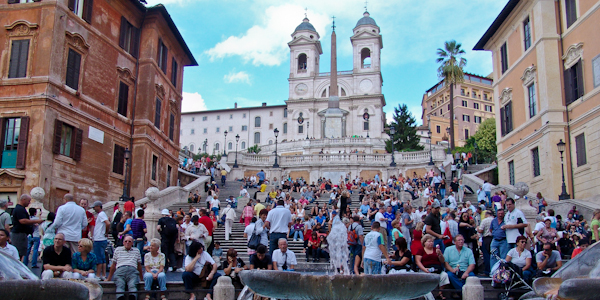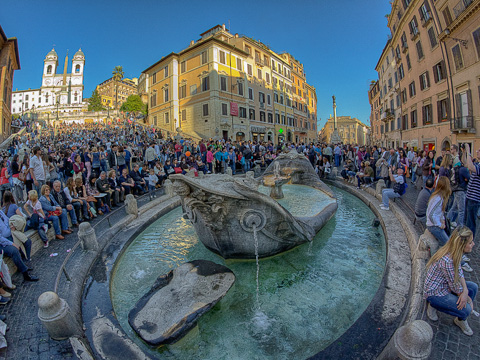

The graceful off-center curves of the Scalinata di Trinità dei Monti (a.k.a. the Spanish Steps; see sidebar below to right) rising from the hourglass Piazza di Spagna are covered with bright azaleas in spring, a life-sized nativity scene in winter, and teem with visitors, Roman teens, poseurs, Italians meeting for the passeggiata, and tour groups year-round.
The steps were built in 1723–25 by Francesco De Sanctis, not on behalf of the Spanish, but for the French as a grand entrée to their twin-towered church of Trinità dei Monti at the top. At the foot of the steps burbles the beloved Barcaccia ("Ugly Boat") fountain, a sinking and leaking marble boat sculpted by a teenage Bernini along with his father, Pietro Bernini.
Piazza di Spagna has long been the Anglo-American center of Rome; the British Consul used to have his office here, and the brick Anglican church lies just a few blocks down Via del Babuino.
Flanking the steps are British 19th-century bastions of Babington's Tea Rooms (genteel and pricey; www.babingtons.net) and, at no. 26, the pink house where Romantic poet John Keats died of tuberculosis in 1821 at the age of 25.
This Keats-Shelley Memorial House is now a small museum to the phenomenon of 19th-century literary greats who liked to bum around Italy—Byron, Shelley, the Brownings, Henry James, Edith Wharton, Goethe, James Joyce, and particularly "Giovanni Keats," including some of his letters and a sketch of him on his deathbed by roomie Joseph Severn (tel. 06-678-4235; www.keats-shelley-house.org; adm). As an interesting side not, you can rent a small apartment in this building for anywhere form three nights to six months.
The less obvious, American connection to the Spanish Steps starts with the location of Rome's American Express office, a few doors south of the steps on the piazza (see sidebar).
In 1985, crowds thronged the piazza to protest the opening of Italy's first McDonald's here (as a teenage ex-pat living in Rome, I showed up excited to get my first burger fix in more than a year; it was awful).
Leading out from the bottom of the steps is the überfashionable Via dei Condotti, the centerpiece for Rome's toniest fashion boutique shopping scene which fills the streets radiating from Piazza di Spagna.
Generally speaking, the streets to the north of Piazza di Spagna toward Piazza del Popolo specialize in art and antiques, while the streets to the west and south focus more on clothing, leather, and jewelry, with names like Gucci, Valentino, Benetton, Ferragamo, Bulgari, and Buccellati.
This neighborhood is also the traditional area for English language bookstores in Rome, including the Anglo-American, at Via delle Vite 102 (tel. 06-679-5222).
(Sadly, several other English bookshops have closed down in recent years, including the one two doors up from the Steps where I voraciously bought paperbacks when I was an adolescent and teen—and, since the bulk of the books were printed in England, is why I still have an annoying tendency to spell things British-style.)
Piazza di Spagna to Piazza Trinità dei Monti
tel. + 39-06-0608
Daily 24/7
Free
Planning your day: For some people the Spanish Steps are something to look at, go "ooh!", snap a photograph, and move on.
Others insist that, since it is a staircase, it must be climbed; that'll take maybe 20 minutes up and down.
Still others enjoy the easygoing vibe and sit on the steps for a while (though, sadly, authorities no longer allow you to picnic here—even to lick an ice cream cone).
If you take time to soak it all in, visiting the Keats House and everything, figure on at least an hour.
Take a guided tour of the Spanish Steps with one of our partners:
Share this page
Search ReidsItaly.com
Piazza di Spagna to Piazza Trinità dei Monti
tel. + 39-06-0608
Daily 24/7
Free
Bus: 117, 119, 116, 116T
Metro: Spagna (A)
Hop-on/hop-off: Piazza di Spagna